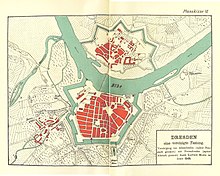Jägerhof (Dresden)
The Jägerhof is a building in Dresden and the oldest architectural monument in Dresden Neustadt . It is located east of the Neustädter Markt on Köpckestrasse. The building was built in the 16th century in the Renaissance style. It originally consisted of four wings, of which only the west wing remains. Today the Jägerhof houses the Museum of Saxon Folk Art . Since 2005 the puppet theater collection has also been housed on the upper floor of the building.

history
At the place where the Jägerhof is today, the Dresden Augustinian monastery previously stood . This was dissolved in 1539 after the arrival of the Reformation and demolished until 1546. From 1569, Elector August von Sachsen had the four-winged Jägerhof built in the style of the Saxon Renaissance . A new upper floor was added up to 1617, completing the construction. On the upper floor was the hunter's hall, which with its paintings and sculptures served to represent the electoral court. At this time, the southern gable received its characteristic shape in the late Renaissance style . In 1654 there were 40 bears in the Jägerhof.
From 1830 to 1877 the Jägerhof served the Saxon military as a cavalry barracks . With the completion of the Albertstadt barracks , the troops were relocated there piece by piece. Then parts of the building were demolished and only the west wing remained, which was rebuilt under the direction of Carl Adolph Canzler and Bernhard Hempel. For example, a workshop, a warehouse and, in the meantime, a poor house were operated there.
Oskar Seyffert saved the Jägerhof from demolition because he had extensive renovation work carried out between 1911 and 1913 in order to set up the Museum of Saxon Folk Art - originally under the name of the State Museum of Saxon Folk Art .
After the air raids on Dresden in February 1945, the two upper floors of the building burned down. Only the first floor with its simple groin vault could be saved in the original, the other parts of the building were later reconstructed. As early as December 1945, the first Christmas exhibition took place in the poorly prepared rooms. The Folk Art Museum reopened in 1950.
Plastic design
The building was built in the Renaissance style. The typical architecture is illustrated by the volutes on the gable and the three polygonal broken stair towers with curved domes.
In front of the building there is a hunter figure with a dog made of sandstone on a plinth. This is a copy by Hans Thiele (1919–2013), made 1979 to 1983, which was pushed from the base in January 2013, renewed by the Dresden Zwingerbauhütte and re-erected in May 2013. The original sculptures, originally placed on the sandstone railing in front of or on the south gable of the building and from around 1900 to 1952 at the Grillenburg hunting lodge , can now be seen in the museum foyer in the building or in the stairwell of the Museum of Hunting Animal and Ornithology in the Augustusburg hunting lodge . They were created around 1645 by Conrad Buchau († 1657) or around 1602 by Christoph Walther IV (around 1572–1626) or around 1620 according to other information.
Located between Jägerhof and the block of flats at the Neustadt market Blütenbaum of Eva Peschel . This ceramic fountain, made in 1979, consists of a 4.7 meter wide and 35 centimeter high well basin and an approximately three meter high trunk. On the trunk with a diameter of 80 centimeters, the flower rosettes are arranged in three levels. On the other side of the Jägerhof there is a folk art fountain, which was rebuilt in 1980. The sandstone column that serves as the water inlet is 215 centimeters high. The 74 centimeter high pool has a footprint of 193 by 193 centimeters.
literature
- Sächsischer Forstverein e. V. (Hrsg.), Herbert Wilhelmi: Forest monuments in Saxony. Central part of the country. 1999.
- Andreas Peschel: Museum for the “art of the little man”. In: Dresdner Latest News , February 16, 2009, p. 16.
Web links
- The Jägerhof at dresden-und-sachsen.de
Individual evidence
- ^ Martin Bernhard Lindau: History of the royal capital and residence city of Dresden. 2nd improved edition, Dresden 1885, p. 451
- ↑ A hunter knocked off the pedestal at the Folk Art Museum returns . Free Press, May 13, 2013.
- ^ André Kaiser: The stone hunters of Grillenburg , Harthaer Gemeindeblätt'l, Official Gazette of the Kurort Hartha community , November 1996, p. 6.
- ^ Art in public space . Information brochure of the state capital Dresden, December 1996.
Coordinates: 51 ° 3 ′ 28.1 ″ N , 13 ° 44 ′ 37.9 ″ E





